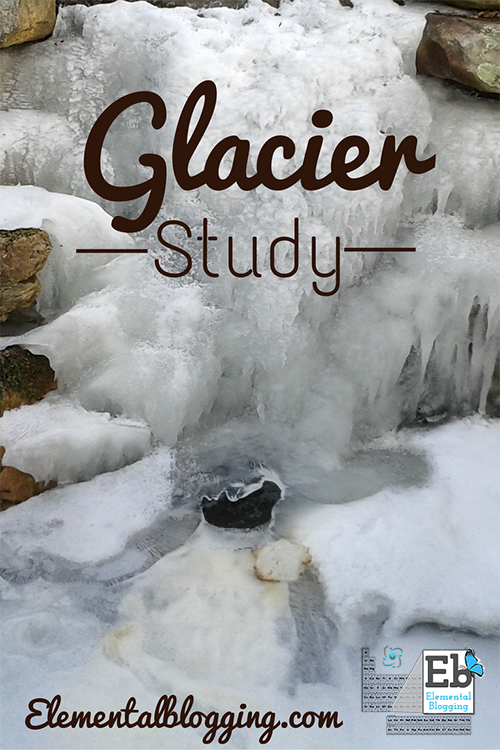 It is the middle of summer and you are no doubt dying for a respite from the heat. To help you out today I am sharing a cool topic – a glacier study.
It is the middle of summer and you are no doubt dying for a respite from the heat. To help you out today I am sharing a cool topic – a glacier study.
These amazing frozen rivers are rare to find in your backyard, but that doesn’t mean you should share them with your students.
In this week’s homeschool science corner you will find an explanation, and a tasty activity for you to use with your students for a glacier study!
What is a glacier?
In a nutshell, a glacier is:
A solid river of ice.
Glaciers are frozen rivers that move slowly downhill. They are found in places where it is always cold, like at the tops of very high mountains or in the Arctic regions.
As the snow falls on the top of one of these mountains, it builds up. The heavy top layers press down on the lower layers, which causes them to form ice.
This ice can be hundreds of feet thick. It slowly begins to move down the mountain and as it does, it picks up rock, clay, sand, and other debris from the mountain. The moving ice also develops dangerous cracks, called crevasses, which scientists can use explore the composition and movement of the glacier.
As the glacier travels further down the mountain, it begins to melt and deposit the mountainous rubble it picked up earlier. The water from the melting glacier creates streams which feed the rivers in the area.
Many years ago there were far more glaciers on the Earth than we see today. We can see the evidence these in the valleys they left behind.
These places will have a hollow where the glacier formed and began to move. This hollow is followed by a u-shaped valley that the glacier dug out as it moved down the mountain. Finally at the end of the valley, we will find a collection of rock, clay, and sand, known as moraine, that was left behind as the glacier melted.
An Edible Glacier
So, now that you understand what a glacier is, you can have the students study glacial movement by making their own edible versions.
You will need:
- A can of sweetened condensed milk
- Cornstarch
- Cereal box
- Chocolate chips or nuts
- Icing
Begin with making the “glacial ice” by mixing one can of sweetened condensed milk with 1-2 TBSP of cornstarch. Heat the mixture of medium heat until it thickens. Pour the mixture into a bowl and let it cool to the touch before using it in your edible glacier.
Have the students cut out pieces of cereal box cardboard to form a mountain. Then, have them place edible rocks made from chocolate chips or nuts all over the mountain. They can use icing to loosely attach the different pieces.
Once they are satisfied with their mountain, have the students place a glob of the glacial ice on top of their mountain and observe what happens. (They should see that their glacial ice slowly moves down the mountain picking up most of the rocks as it goes. Once the ice reaches the bottom, the students can eat the remains of their glacier.)
Dig Deeper
If you have older students, you may want to have them make several mountains with different slopes to see if the angle of the hillside affects the movement of the glacial ice.
You can also have your students read more about glaciers from the following books:
- Glaciers (Natural Wonders) by Mari Schuh, Kelly Garvin and Gail Saunders-Smith
- Glaciers (Blastoff! Readers: Learning about the Earth: Level 3) by Colleen Sexton
If you are lucky enough to live near glacier, head outside and check it out! If not, the Glacier National Park website has some good information on glaciers you can check out.
The Final Product
A glacier is really just a river of flowing ice. It is so powerful that it can pick and move boulders that lie in its path, which your students will understand when they make the edible glacier above.
I trust you will enjoy learning about glaciers. If you have any questions along the way, please feel free to leave them in the comments.
 Sign up below to receive weekly tips & tools for homeschool science and we'll send you a FREE copy of
Sign up below to receive weekly tips & tools for homeschool science and we'll send you a FREE copy of 